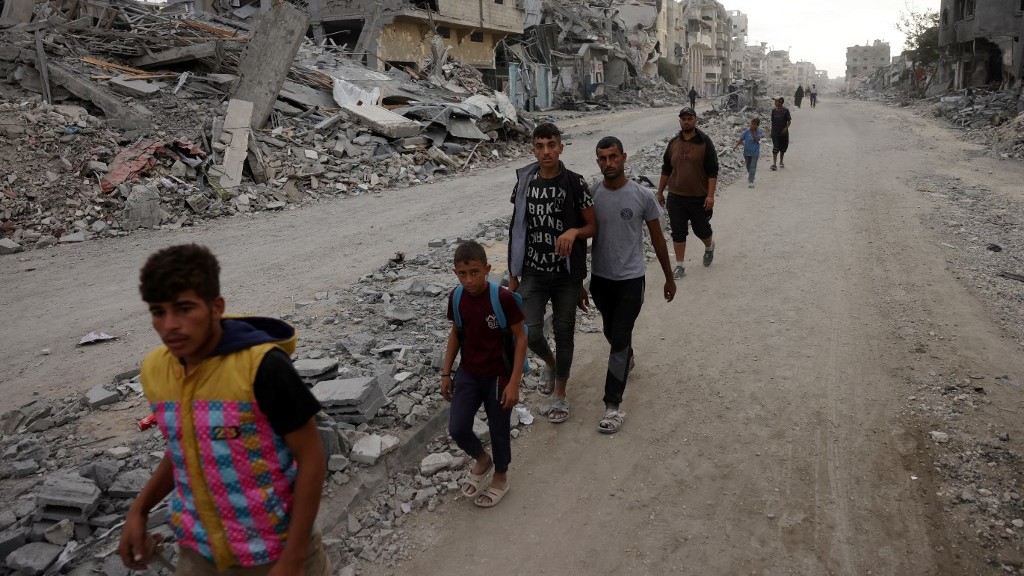Aid trucks have begun to arrive in Gaza, as UN agencies prepare to dramatically scale up deliveries as part of a ceasefire deal which stipulates that 400 trucks will enter the strip daily.
This is set to increase to 600 – the minimum number estimated by the UN required to address the humanitarian crisis in the strip.
The increase in aid comes as Hamas announced it would release its remaining captives on Monday, as US President Donald Trump and other world leaders prepare to meet in Egypt for a major peace summit.
The president will first pass through Israel before heading to Egypt’s Sharm El-Sheikh for the summit, where a “document ending the war in the Gaza Strip” is expected to be signed, according to Cairo’s foreign ministry.
Trump’s 20-point plan states that the entry and distribution of aid into Gaza will “proceed without interference”, but Israeli administrative restrictions and bureaucracy have long hampered the flow of badly needed aid into the territory.
New MEE newsletter: Jerusalem Dispatch
Sign up to get the latest insights and analysis on
Israel-Palestine, alongside Turkey Unpacked and other MEE newsletters
Large-scale aid distribution will be led by the United Nations, although the role of the UN Agency for Palestinian Refugees (Unrwa) in the operation remains unclear.
The agency has said that half the supplies stored in warehouses outside Gaza belong to them, emphasising that their scope and expertise within the territory is “absolutely critical in controlling the spread of famine”.
An estimated 460 Palestinians have died from Israeli-imposed starvation since it launched its genocide in Gaza in October 2023.
The UN children’s charity Unicef warned that there is a risk of a “massive spike in child death, not only neonatal, but also infants, given their immune systems are more compromised than ever before”.

Gaza ceasefire: What we know about the first phase
Read More »
As the UN prepares to take over aid distribution, the scandal-plagued US and Israeli private contractor Gaza Humanitarian Foundation (GHF) is dismantling its hubs across the strip.
Israeli soldiers shot large numbers of Palestinian aid seekers at the distribution sites, which one UN official described as “sadistic death traps”.
Al Jazeera reported that remnants of Israeli munitions that had been used to attack Palestinians were found at the sites.
Mutual aid groups told Middle East Eye that tents, trailers and materials for constructing shelter are the number one priority given the onset of wintry weather, shortly followed by medical supplies and doctors.
Mohammad Zaqout, the director general of hospitals in Gaza, told Al Jazeera that medical supplies and medicines are urgently needed, but none have arrived yet. He added that Israel is obstructing the entry of medical delegations into Gaza.
Captives exchange
Hamas has informed Israel that it is prepared to begin releasing the 20 living Israeli captives held in Gaza.
Israeli security sources said that the group had started moving captives to assembly points in Gaza, although it remains unclear whether they will be released from multiple locations or a single point.
The Directorate for Hostages, Missing Persons and Returnees at the Israeli prime minister’s office said on Sunday that preparations to receive the remaining living captives have been completed.
Meanwhile, a review conducted by Palestinian attorneys has revealed that only 63 of the 250 Palestinian prisoners slated for release on Monday are Hamas members.
Among them, 18 are serving life sentences, 26 are detainees and 16 are serving shorter sentences.
According to the review, among the 191 prisoners set for release who are serving life sentences, 150 are affiliated with Fatah, 18 with Hamas, and 23 with the Popular Front for the Liberation of Palestine and Islamic Jihad.

